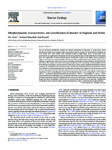Morphodynamic characteristics and classification of beaches in England and Wales
Date
2011-08-01Author
Subject
Metadata
Show full item recordAbstract
The use of beach classification models has become widespread in literature in recent years. Beach classification models that recognise distinct modal beach states in response to environmental conditions are most widely used. These models were developed largely in high-energy, micro- to meso-tidal sandy environments and subsequent attention has focussed on extending their use into other beach environments. Here, the applicability of these traditional beach classification models to the highly diverse coastline of England and Wales was assessed through collection of detailed morphodynamic characteristics of 92 beaches, yielding a comprehensive multi-variate data set containing morphological, sedimentological and hydrodynamic information. The complex and diverse study region incorporates beach morphology covering the full spectrum from reflective to dissipative, and non-barred to multi-barred. Cluster analysis supplemented by MDS ordination resulted in the identification of 9 distinct beach types. Traditional morphodynamic indices Ω and RTR were found to be effective in discriminating between beach groups providing some support for the beach state models derived using information from Australian beaches. It was found that absolute wave energy (wave power) is important as well in controlling beach type. For intermediate beaches a wave energy flux P (αH2T) value of 3kWm>1 was found to differentiate between beaches with (P>3kWm-1) and without (P<3kWm-1) three-dimensional bar/rip morphology, a key component controlling recreational beach hazard levels. Observations presented here inform a beach classification model to be used as the basis for a national beach risk assessment programme. Beach classification models based on environmental parameters are, by necessity, simplifications and should be used as tools for understanding morphodynamic systems, rather than beach type prediction. © 2011 Elsevier B.V.
Collections
Publisher
Journal
Volume
Issue
Pagination
Recommended, similar items
The following license files are associated with this item:
Related items
Showing items related by title, author, creator and subject.
-
INTER-ANNUAL OBSERVATIONS OF BEACH EVOLUTION AT SLAPTON USING VIDEO IMAGES AND FIELD SURVEYS TO MAP INTERTIDAL BEACH BATHYMETRY
McConnell, Rachel Victoria (University of Plymouth, 2007)Observations of shoreline evolution were obtained during an inter-annual period from January 2006 until July 2007 on a gravel barrier beach in Devon. The location of the beach between two villages and the transport link ... -
Short Term Beach Recovery of a Macro Tidal Beach System Following Consecutive Storms
Jenkins, Graham Paul (2014)Storm induced morphological change of a beach system can be swift and significant; this change can be considerably amplified if multiple storms occur consecutively. The knowledge of the subsequent morphological change ... -
Short-term interrelationship of intertidal beach morphology and sediment distribution, Sennen Beach, UK
Auger, Nigel Charles (University of Plymouth, 2010-11-02T16:46:23Z2005)The interrelationship between beach morphological and sediment grain-size response was investigated across Sennen Cove beach, UK, between 5 and 25 May 2005. A low tide terrace beach type, a single cross-shore beach ...


